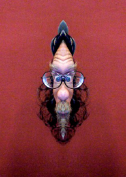We’re honored this month to have Clifford A. Wheeler as our judge for the still life competition. He brings a unique sensibility to photography and is sure to offer insightful critiques on the images we show him.
 Let Cliff introduce himself to us first, in his own words: “As a photography major in a school of fine art, I was often asked to photograph artwork for other students…the painters, sculptors, and printmakers I knew. And I enjoyed a reputation for color accuracy, which I then parlayed into a small studio business upon graduation. Around the same time, I began working as a commercial picture framer and started collecting the tools I would need to produce my own work from start to finish. Roughly five years later, I was offered the opportunity to become a member of a gallery of like-minded photographers in an old munitions factory in Alexandria, Virginia. As a gallery member, my job was to install the monthly exhibitions. I purchased a full size utility van to move artwork.
Let Cliff introduce himself to us first, in his own words: “As a photography major in a school of fine art, I was often asked to photograph artwork for other students…the painters, sculptors, and printmakers I knew. And I enjoyed a reputation for color accuracy, which I then parlayed into a small studio business upon graduation. Around the same time, I began working as a commercial picture framer and started collecting the tools I would need to produce my own work from start to finish. Roughly five years later, I was offered the opportunity to become a member of a gallery of like-minded photographers in an old munitions factory in Alexandria, Virginia. As a gallery member, my job was to install the monthly exhibitions. I purchased a full size utility van to move artwork.
Flash ahead thirty years…Kodak no longer makes my favorite film, so I’ve shut down my studio operation, and as well, no longer do commercial framing. Folks did start noticing the exhibitions I was installing all around the Metro area, though. I now function as Lead Installer of Exhibitions for many area galleries and museums, designing and installing exhibitions in all media, but I prefer specializing in exhibitions of photography. I’m on my third van, and it’s coming up on 150,000 miles.”
Clifford Wheeler also gives us a fascinating glimpse into his thinking on his own photography: “Making photographs has always been an opportunity to both capture a moment when the unique combination of light and form best reflects the essence of the ‘thing itself,’ and the technical challenge of actually creating something tangible, something that can be held in the hand…and shared between individuals.
“I often do this for no other reason than sentimentality itself. Using photography to explore this world into which I was born, sometimes I’m left feeling like a writer learning the meaning of the words I will use to tell a story.”
